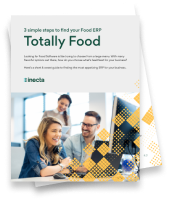In today’s competitive food industry, profitability depends on more than great products — it requires data that is accurate, structured, and ready for action. ETL (Extract, Transform, Load) technology is the backbone of this process, enabling food businesses to gather data from multiple systems, clean it, and store it in a single, reliable source.
This article explores the financial advantages of ETL, including how it can reduce costs, improve forecasting, and ultimately drive profitability for food businesses.
1. Reducing Costs with Clean Data

Minimize waste and spoilage
ETL processes ensure your production, inventory, and sales data are unified, allowing you to match production to actual demand. This prevents costly overproduction and reduces spoilage — a critical concern in perishable goods industries.
Operational efficiency through automation
By automating data extraction and transformation, ETL reduces manual entry, eliminates human error, and frees up staff to focus on higher-value work. This operational efficiency translates directly into reduced labor and overhead costs.
2. Improving Forecasting Accuracy

Reliable demand prediction
Clean, consolidated data allows forecasting models within your ERP to produce accurate projections. For food businesses, this means you can plan production, purchasing, and distribution more precisely — avoiding both stockouts and excess inventory.
Industry example: Seasonal demand planning in produce distribution
A mid-sized produce distributor integrated sales history, vendor lead times, and seasonal demand patterns into a single, clean dataset using ETL. This enabled their forecasting team to predict weekly demand for perishable items with far greater accuracy, resulting in reduced emergency purchase orders and better alignment between inventory levels and customer demand.
3. Driving Profitability

Accurate cost and margin tracking
ETL allows for precise consolidation of financial data, giving decision-makers a clear picture of actual product costs and margins. This makes it easier to identify unprofitable product lines and adjust pricing or operations accordingly.
Smarter strategic decisions
Clean data empowers leadership teams to analyze profitability drivers in real time — whether that’s adjusting production batch sizes, renegotiating supplier contracts, or optimizing delivery routes.
Enabling AI and advanced analytics
With clean, structured data from ETL, your business can easily adopt AI tools for demand forecasting, cash flow projections, and inventory optimization — future-proofing your operations against market volatility.
Summary: ETL’s Financial ROI for Food Businesses
| Benefit Area | How ETL Helps | Financial Impact |
|---|---|---|
| Cost Reduction | Aligns production with demand, reduces waste | Lower inventory costs, reduced spoilage |
| Forecast Accuracy | Improves seasonal and daily demand planning | Fewer lost sales, optimized purchasing |
| Profitability | Clarifies cost and margin data | Better pricing, stronger bottom line |
Final Thoughts
For food businesses, clean data is a direct path to profitability. ETL technology — especially when integrated with a purpose-built solution like inecta Food ERP — ensures that your information is accurate, accessible, and ready to drive smarter decisions.
By investing in ETL, companies can cut costs, forecast more accurately, and unlock the insights needed to grow in an increasingly competitive marketplace.











Free Valuable Resource!
3 simple steps to find your Food ERP
Free Valuable Resource!
3 simple steps to find your Food ERP
*We will never sell your information. Keeping your data and privacy secure is our highest concern.